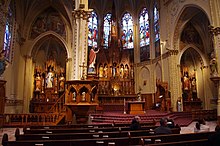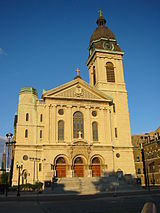

The Polish cathedral architectural style is a North American genre of Catholic church architecture found throughout the Great Lakes and Middle Atlantic regions as well as in parts of New England. These monumentally grand churches are not necessarily cathedrals, defined as seats of bishops or of their dioceses.
Polish cathedral churches generally have large amounts of ornamentation in the exterior and interior, comparable only to the more famous Churrigueresque or Spanish Baroque style. The decorations used reflect the tastes of the Polish immigrants to these regions in both the symbols and statuary of saints prominently displayed throughout. Additionally there is a heavy proclivity towards ornamentation drawn from the Renaissance and Baroque periods as well as modeling designs after famous churches in Poland. The claim of different 'architectural styles' of Europe ascribed to these churches is misleading, as most of them are already labeled by art historians as examples of Eclecticism and Historicism, characterized by the various architectural revivals found in styles of the late 19th and early 20th centuries. These churches exhibit a mixture of architectural traits from numerous past eras characteristic of Europe and the Americas.
A unique synthesis


Skerrett says Polish churches surpassed other immigrants' churches in size. Their style promoted the immigrants' vision of Polish identity.
Kantowicz writes in The Archdiocese of Chicago: A Journey of Faith: "The preference of the Polish League for Renaissance and Baroque forms seems more clear cut. The glory days of the Polish Commonwealth came in the sixteenth and seventeenth centuries when it formed the largest state in Europe… The architectural style of Chicago's Polish churches in Chicago reflect this, particularly the magnificent edifices of Worthmann and Steinbach built along Milwaukee Avenue on the Northwest Side, reflected the renaissance glory of Polish Catholicism".

Peter Williams in his book Houses of God: Region, Religion, and Architecture in the United States on p. 179 writes,"n Detroit and Chicago especially, a distinctive genre of church building emerged among Polish communities, the "Polish cathedral." Where most Catholic churches were built in grander or humbler variations and Gothic and Romanesque themes popular across the country, the ambitious prelates in the Great Lakes Polonias often chose to make monumental statements in the Renaissance style of their mother country. The scale of these structures was often enormous, both in the great size of these parishes and the episcopal ambitions of their clerical leaders... Still visible from the freeways, many of these "cathedrals" such as St. Stanislaus Kostka in Chicago now serve African-American or Latino constituencies while others have been closed by their archbishops as no longer economically viable.

The churches are major tourist attractions in Chicago, with tours devoted exclusively to them. In May 1980 the Chicago Architecture Foundation's ArchiCenter held an exhibit on these treasures titled Chicago's Polish Churches.
These ornate temples were largely built by the working poor in these regions in the era spanning the period from the end of the American Civil War until the end of World War II.
Criticism
Many of Chicago's Protestant elites criticized these stylistically grand churches as "ostentatious" in comparison with the "plainer" style in vogue for Protestant houses of worship. Catholic hierarchs such as John Lancaster Spalding, the first Bishop of Peoria, responded by comparing the churches that the immigrants financed to the pyramids of Egypt that were built by slaves.
The need for identity was evident in the unique architecture of the Polish cathedral style. It was often associated with the religious order of the Congregation of the Resurrection, in addition to the architectural styles of the Renaissance and Baroque periods. Both in scale and scope, these edifices were attempts to contradict the marginal status of Polish immigrants in society. As a stateless people whose culture was systematically attacked in its homeland during the years of partition, they also had a low economic rank in the industrial centers to which they had immigrated at the turn of the century. The construction of these churches greatly influenced the development of neighborhoods that surrounded them. World views that the Polish immigrants from the Old World retained, and their creative assimilation into the New World, shaped the landscape of the rapidly growing industrial regions to which they immigrated.
List of churches built in the Polish cathedral style
See also
- Eclecticism
- Eclecticism in art
- Jozef Mazur, Polish-American painter and stained-glass artist
- Tadeusz Żukotyński, Polish Catholic fine art painter and mural artist
- Sr. Maria Stanisia, Polish-American fine art painter and restoration artist
- Czesław Dźwigaj, Polish Catholic artist and sculptor
- Holy Cross in Chicago, an ornately decorated church founded by Lithuanians in Chicago's Back of the Yards, which displays architectural affinities with the architecture of Polish cathedrals.
- Polish Americans
- Poles in Chicago
- Polish Roman Catholic Union of America
- Roman Catholicism in Poland
References
- Notes
- Williams, Peter W., "Houses of God: Region, Religion, and Architecture in the United States" pp. 157, 179–180 University of Illinois Press; Reprint edition (2000)
- "Polish churches along the Kennedy Expressway" by Lilien, Marya, pp. 18–29, Spring 1980
- The Archdiocese of Chicago: A Journey of Faith by Kantowicz, Edward pp. 27–29, Booklink, Ireland 2006
- SKERRETT, Ellen. "Parish and Neighborhood in Polonia". Sacred Space. Catholicism, Chicago Style. p. 153.
In terms of sheer size and monumentality, Polish Catholic churches on the Near Northwest Side surpassed the parish churches constructed by most German, Bohemian and Irish congregations. The architectural style promoted by the Resurrectionists used Renaissance and Baroque forms molded to distinctively promote their vision of Polish history and identity.
- Polish Spires and Steeples Tour" Archived 2009-07-15 at the Wayback Machine
- Chicago Special Interest: "Polish cathedral"
- Chicago's Polish Downtown Victoria Granacki in association with the Polish Museum of America pp. 7–11, 14–16, 18–23 Arcadia Publishing 2004
- Williams, Peter W., "Houses of God: Region, Religion, and Architecture in the United States" p. 178 University of Illinois Press; Reprint edition (2000)
- ^ Catholicism, Chicago Style by Skerrett, Ellen; Kantowicz, Edward R.; and Avella, Steven M., p. 147, Loyola University Press, 1993
- Ethnic Chicago: A Mulicultural Portrait edited by Melvin G. Holli and Peter a'A Jones, pp. 178–9, 595–6, William B. Eerdman's Publishing Company, 1995
- Swiderski, Klara and Robert, "Basilica of St. Hyacinth: Inside Religion", pp. 3–8, Ex Libris Galeria Polskiej Ksiazki, 2005
- Piatkowska Danuta Polskie Kościoły w Nowym Jorku (The Polish Churches of New York ), pp. 19–27, 559–61, Wydawnictwa Swietego Krzyza, 2002
- Catholicism, Chicago Style by Skerrett, Ellen; Kantowicz, Edward R.; and Avella, Steven M., pp. 139–40, 146–50, 152–62, Loyola University Press, 1993
External links
- "Polish Cathedrals" on Google Arts and Culture
- Polish American Catholic Heritage Committee website
- The Polish Churches of Milwaukee/
- Poland's Most Beautiful Churches
| Roman Catholicism in North America | |
|---|---|
| Sovereign states | |
| Dependencies and other territories | |